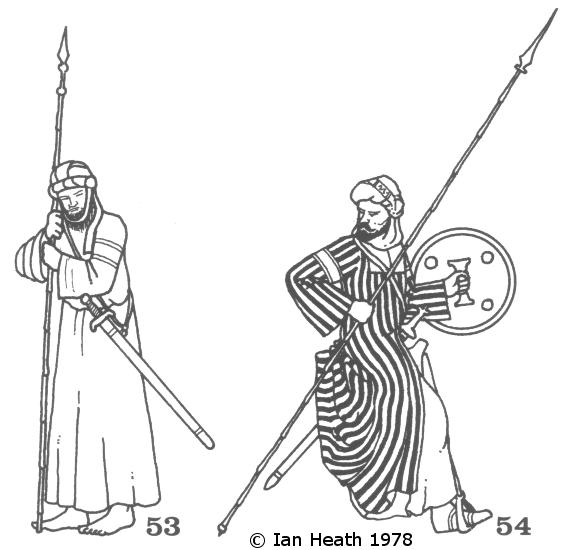BEDOUIN TRIBESMEN
An extract from Armies and Enemies of the Crusades 1096-1291by Ian Heath
 | ||
| [Based on illustrations in Hariri's Maqamat] | [Based on illustrations in Raschid al-Din's Jami' al-Tawarikh] | |
 | ||
| [Based on illustrations in Hariri's Maqamat] | [Based on illustrations in Raschid al-Din's Jami' al-Tawarikh] | |
53 & 54. BEDOUIN TRIBESMEN
The Bedawis or Bedouins were principally noted as brigands during this era and were as likely to be found robbing their fellow-Moslems as they were to be fighting the Franks, 'it being well-known,' as Joinville records, 'that the use and custom of the Bedouins is always to fall upon the weaker side.' Nevertheless Bedouins appeared as auxiliaries in most Moslem armies (and also in some Frankish ones), serving mainly as cavalry though infantry are also recorded on occasions. In Frankish employ they usually supplied scouts and spies.
These 2 figures date respectively to c. 1237 (Hariri's Maqamat) and c. 1306 (Raschid al-Din's World History) and tally closely with the description of Bedouin dress left to us by Joinville in his Memoirs of the Seventh Crusade. He records their characteristic camel-wool tunic, the long, wide-sleeved Gubba, as covering the whole body down to the ground, while the turban was wrapped around the head in such a way that one strip went beneath the chin, as can be seen in both these figures. In the sources clothes are depicted or described as dyed chiefly in bright colours, predominantly reds and blues of most shades. Striped clothing of the type worn by 54, popularly associated with Arabs, only became commonplace from the 12th century. Hair was black.
Joinville also records a Bedouin belief 'that no-one can die save on the day appointed, and for this reason they will not wear armour,' and that 'in battle they carry nothing but sword and lance', which basically repeats William of Tyre's comment that 'according to their custom' they 'fought with lances only.' Burchard of Mount Sion, who wrote c. 1270, adds that 'they do not use arrows, saying that it is base beyond measure to steal away a man's life with an arrow.' The lance was usually of cane ('reed'). The sword was generally suspended from a baldric across the right shoulder, the Bedouins apparently adhering to this traditional Moslem custom rather than following the prevalent habit of girding on the sword at the waist; other than the Bedouins only Nur ed-Din's army appears to have regularly used the baldric.
The Byzantine Scylitzes ms. of c. 1200 depicts Moslem horsemen in dress identical to that worn by these figures, and likewise armed with lance, sword and shield (most of the shields resemble that of 30, though a few apparently carry crescent devices).